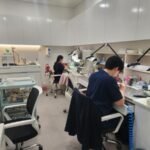SK Hynix plans to double its HBM chip output in 2025
South Korea’s two leading memory chipmakers – Samsung Electronics Co. and SK Hynix Inc. – are moving to significantly reduce their production of legacy memory chips, particularly DRAM, amid falling prices caused by increased volumes from Chinese companies.
Samsung and SK Hynix, the world’s No. 1 and No. 2 memory chipmakers, respectively, plan instead to steadily increase production volumes of cutting-edge products such as high-bandwidth memory (HBM) and enterprise solid-state drives (eSSDs).
During its earnings conference call with analysts on Thursday, Samsung executives said the company plans to slash its production of legacy DRAM and NAND flash chips, confirming market talk that chipmakers are cutting down on conventional memory chips.
“We are adjusting production volumes downward for general-purpose DRAM and NAND flash in line with falling market demand,” said Kim Jae-joon, executive vice president of Samsung’s device solutions (DS) division, at the call.
Chinese chipamaker’s ramp-up of legacy DRAM chips creates a memory supply glut (Courtesy of Getty Images)
According to industry sources on Friday, SK Hynix said in a recent investor relations session with Goldman Sachs that it plans to lower its DDR4 DRAM chip production to 20% of its entire DRAM output by the end of the year from 30% at the end of September and 40% at the end of June.
Samsung and SK’s moves come as major tech companies such as Google Inc. and China’s Baidu continue to invest in servers, leading to steady server DRAM demand, whereas sales of PC DRAM chips have stalled.
The global semiconductor market has been recovering from last year’s downturn, driven by chips used in AI devices and servers. Still, demand recovery for conventional chips used in smartphones and PCs is slowing.
Market research firm TrendForce recently revised down its forecast for PC DRAM price increases in the fourth quarter to flat from a hike of 3-8% it projected in September.
Industry data show while server DRAM is booming, with its prices rising due to strong demand for AI-powered devices, the prices of DRAMs for PCs and smartphones have been steadily dropping.
Samsung and SK Hynix plan to reduce their coventional DRAM chip production (Courtesy of Yonhap)
The price gap between traditional DRAMs and cutting-edge new products such as HBM is also widening.
CHINA’S CXMT RAMPS UP LEGACY CHIPS
The widened price gap was largely due to increased production of older chips such as DDR4 and LPDDR4X by China’s ChangXin Memory Technologies (CXMT), according to industry officials.
According to TrendForce, Chinese memory chipmakers are expected to control a combined 11.8% market share in the DRAM segment by the end of this year, up from 10.1% in the first quarter.
Now the world’s No. 4 DRAM maker, CXMT’s monthly DRAM production capacity has expanded to 160,000 sheets in terms of wafers, from 40,000 sheets in 2020. Its monthly production capacity is forecast to rise to 200,000 sheets by the end of this year and further to 300,000 sheets by the end of 2025.
Morgan Stanley, in a recent research note, said it expects CXMT’s DRAM output to surpass 10% of the global total by year-end.
Samsung’s HBM3E chip
SK HYNIX TO UP ADVANCED MEMORY OUTPUT
SK Hynix expects the global HBM market to reach $40 billion next year – a more aggressive forecast than rival Micron Technology Inc.’s $25 billion estimate.
SK executives said the company aims to double its HBM supplies in 2025 to retain its market share above 50%. The company is the top HMB supplier with a 52.5% market share.
Regarding its production of next-generation HBM4, SK plans to prioritize standard chips over customized ones, which it is working on with its HBM4 partner TSMC, sources said.
Judging that a global supply glut will be protected, SK plans to speed up SK the conversion of its older DRAM lines in Wuxi, China to more advanced lines to make products such as the fourth-generation 10-nanometer 1a DRAM.
While keeping the pace of its standard NAND flash production at the current level, SK is upping the operation rate of its eSSD facility in Dalian, China to nearly 100%, sources said.
China’s Yangtze Memory Technologies Co. (YMTC) recently developed SSDs for data storage after mass-producing its latest 232-layer NAND flash.
SK Hynix affiliate Solidigm launches the world’s highest-capacity SSD with a PCIe interface in July 2023
SAMSUNG TO UP AI CHIP INVESTMENT
Samsung’s recent chip business strategy is to increase investment in high-end products such as HBM, eSSD and LPDDR5.
For HBM4, Samsung is leveraging its strengths in design and production to develop customized products for its clients.
Samsung has also forged a tie-up with its foundry rival TSMC for HBM4 chips.
Samsung plans to allocate the majority of its 48 trillion won ($34.8 billion) in 2025 chip investment to AI memory facilities and related R&D projects.
Samsung has been scrambling to catch up with smaller crosstown rival SK Hynix in a race to supply advanced HBM chips to Nvidia Corp., the world’s top AI chip designer.
While more than half of SK Hynix’s sales revenue comes from HBM and other high-value server DRAMs, Samsung has a relatively higher proportion of smartphone and PC DRAMs.
By Jeong-Soo Hwang and Eui-Myung Park
hjs@hankyung.com
In-Soo Nam edited this article.















